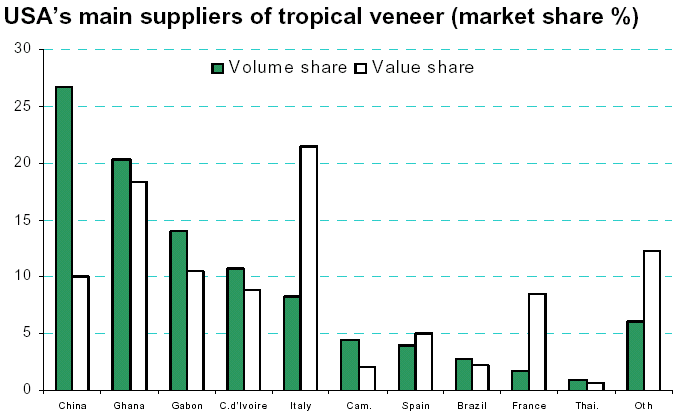| Home: Global Wood | Industry News & Markets |
¡¡
¡¡
| Home: Global Wood | Industry News & Markets |
|
North
American Lumber Market | ||||||||||||||||||||||||||||||
|
Analysis of the US tropical veneer market - Part II As reported in the previous issue, the USA imported 30.5 million m2 ($41 million) of tropical veneer in 2005, up 34% and 32% from 2002 in volume and value terms, respectively. With regards to tropical veneer, USDA statistics only distinguishes between meranti and non-meranti veneer. However, only some 1.2% of the volume (2.6% of the value) of tropical veneer imported is meranti veneer, mainly from Indonesia. On average, meranti and non-meranti veneer were priced at $2.58 and $1.33 per m2 as of 2005. Between 2002 and 2005, the import volume of meranti veneer remained largely stable while that of non-meranti veneer advanced by about one-third. Furthermore, meranti prices declined while non-meranti prices remained stable, resulting in a market share loss for meranti both on a volume and in particular on a value basis. China is by far the largest volume supplier of tropical veneers to the USA, accounting for 8.2 million m2 (27%) of total imports in 2005. Veneers supplied by China are modestly priced, averaging only $ 0.51 per m2 and accounting for only $4.1 million (10.1% of the total import value). However, China seems set to overtake Italy and Ghana as the largest supplier of veneer in value too. Between 2002 and 2005, China¡¯s veneer exports climbed 2,566% in volume terms and 1,576% in value terms. No other country is coming close to such staggering growth rates. 
With a volume market share of 20.3% (6.2 million m2), Ghana is USA¡¯s
second largest supplier of tropical veneer. Ghanaian veneer is one of the most pricy among
all the tropical supplier nations, averaging $1.21 per m2 in 2005. As a result of the premium price, its import Gabon follows in third place with a volume and value market shares of 14% and 10.5% (4.3 million m2 and
$4.3 million) in 2005. Veneer shipments from this country have been growing impressively by 73% in
volume and 105% in value between 2002 and 2005. The average price of Gabonese veneer was $1.01 per m2,
higher than Chinese veneer but lower than Ghanaian A fairly large quantity of tropical veneer in the USA comes from non-tropical countries, which re-export
tropical veneer, usually in a ¡°refined¡± form at a higher value-added price. The most important countries within
this group are Italy, Spain and France, which together accounted for 14% and 35% of the market share in
volume and value terms. With 2.5 million m2, Italy was
| ||||||||||||||||||||||||||||||
|
Abbreviations
| ||||||||||||||||||||||||||||||
|
Source: ITTO' Tropical Timber Market Report |
CopyRight 2006 Global Wood Trade Network. All
rights reserved
¡¡